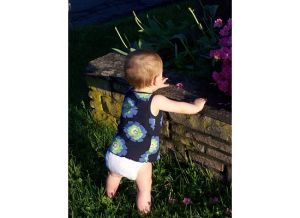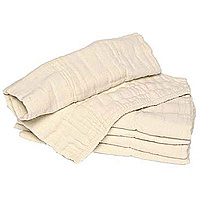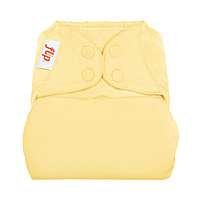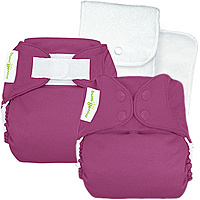Cloth diapers are easy and inexpensive. That is not a sentence most people would understand. Just three years ago I wouldn’t have understood it either. But now as I prepare to cloth diaper two children, it is truer than ever.
When we began trying to get pregnant with our first child, my husband and I were looking for ways to save money. I desperately wanted to stay home with our child, but the numbers didn’t look good. In the dozens (if not hundreds) of articles I read on saving money with babies I found a few references to cloth diapers. But I was baffled. I remembered my mother had used cloth diapers when we were young (prefolds and plastic pants), but I never seriously considered them for myself. Just a few weeks and many hours of research later I was almost completely sold. The cold hard numbers were hard to argue with.
$200-$1,000 for cloth diapers.
$40 for 3 dozen cloth wipes
$40 for 2 washable diaper pail liners
$45 for a heavy duty diaper pail
$1,200-$3,000 for disposables. (Assuming $600 a year for two years.)
$160-$200 for disposable wipes ($80-$100 a year assuming two wipes per change)
$250 Diaper Genie refills ($125 a year for two years).
$35 Diaper Genie
(Neither of those numbers include the cost of pull-ups or cloth training pants during the potentially long potty training process. For the record, I have spent approximately $150 on cloth training pants which we have been using on and off for more than six months. Pull-Ups normally run $.30 to $.40 each. Depending on how many a day your child goes through, a six month potty training stint could cost $300 or more)
Now these numbers are averages based on typical cost in my area of the country. I also used averages because newborns use more diapers than toddlers and potty training age varies so greatly. Many children (including mine) do not potty train at age two. So you are still buying diapers for a while, increasing how much you spend. Some people I’m sure can use many fewer disposable diapers a day and perhaps always buy the store brand in bulk. Others always buy the name brand in the smallest package because they don’t have the money to buy in bulk or their children can only tolerate a specific brand of diaper. More eco-friendly disposables cost significantly more than traditional ones as well.
On the flip side, there are families that spend much less on cloth diapers than others. You can buy used, make your own or shop sales very carefully. Making your own cloth wipes can be a huge savings. Personally I find the cost of washing my own diapers negligible, but for some families expensive specialty detergent or high water cost can affect this number. Some cloth diaper families forgo the diaper pail altogether, instead opting for a hanging wet bag, which saves money over a diaper pail and reusable liners.
When first deciding on cloth diapers my husband was intimidated, even more so than I was. There were some very easy to use diapers on the market, but the more convenient the more expensive. One-size diapers lasted longer in theory, but what if they wore out or ended up being a poor fit for our baby? We’d be stuck with them. Many cloth diaper retailers offer newborn rental programs or sampler packs to let families try cloth for a very reasonable fee before committing full time. There is also a thriving online market for used cloth diapers, especially those that are almost new. Sometimes you can even sell your entire stash of cloth diapers when you are finished with them, helping to recoup some of the cost.
Personally I recommend a combination system. Buy a few diapers each month during pregnancy, taking advantage of sales or great prices on gently used products whenever possible. Try a couple of each kind: prefold, fitted, pocket, All-In-One, One-Size. The terminology can be overwhelming but most online retails have a Cloth Diaper Basics page and a glossary to help you learn the ropes.
As for my personal experience, the best bang for your buck is one-size pocket diapers and prefolds with covers. Newborns go through a lot of diapers. My daughter used 12 or more many days and she kept using 6-8 a day until she was well over a year old. We would have been spending way more than the average on disposables. Prefolds are inexpensive so it’s easy to have a large supply on hand and they wash easily with few problems. One-size pocket diapers are almost as easy to use as disposables (sometimes easier in my opinion) and while they are more expensive per diaper, the fact that they will probably fit until potty training helps to make up for that fact. How many times have you had part of a pack of disposable diapers go unused because your baby grew out of them too quickly?
Below are a couple of potential diaper stashes. There are so many other options out there included fitted diapers with covers, sized pocket diapers (such as FuzziBunz Perfect Size) and All-In-Ones. But for the sake of simplification I’m only featured a couple of options. (Prices reflect those of Cotton Babies rounded to the nearest dollar amount. Cotton Babies was one of the first cloth diaper retailers I discovered and still one of my favorites.)
$100-$150 to cloth diaper from birth until potty training.
This is a unique system of one-size covers and one-size prefolds created by Cotton Babies. This can be one of the cheapest cloth diaper options available.
$50 buys 3 covers, 12 prefolds and 1 wet bag. Recommendation is that you buy two and wash your diapers every other day. Personally I’d recommend either 3 Kits or purchasing extra prefolds ($6 for 3) and covers ($8.95 each).
Prefolds and Covers combination.
$300-475
Prefolds are fairly standard in price. Infant prefolds cost $1.50, Premium (the larger size) are $2 each. The difference between Indian and Chinese prefolds is mostly a matter of preference. I have used both and each works great, but I like the off white color of Indian prefolds better as it doesn’t show staining much. Diaper covers on the other hand have a huge range in price. My personal favorite are the Thristies and Thirsties Duo covers. Others swear by one-size covers like Flip and Kissaluvs. For the sake of argument let’s assume Thirsties traditional sized covers.
24-36 prefolds in infant size
18-24 prefolds in premium size
5-6 XS covers
5-6 S covers
4-5 M covers
4-5 L covers
2 packs of Snappis.
Snappis are a great little item that is used to secure a cloth diaper instead of pins. These are not necessary, as a prefold can simply be folded and laid inside the diaper cover, but I personally love them. As I said, the over all price is based mostly on what covers you choose. Using a one-size cover could save money, as well as a two size cover such as Thirsties Duo wrap. Since covers can be reused until soiled or smelly, some people can get by with fewer in each size. As always, the number of times a week you do laundry affects how many diapers you need to have.
Insert and Cover System such as Flip from Cotton Babies
$164-214
The Flip system is another great invention from Cotton Babies that consists of an absorbent insert laid inside of one size cover. No pinning, no stuffing. Just lay the insert in the cover and snap on the cover. A similar product is available from Grovia or using Thirsties Duo covers and Duo Diaper inserts.
$100-$150 for two or three Flip Stay-Dry Day packs (6 inserts, 2 covers)
$24-36 for 12-18 newborn size inserts
$28 for 2 extra covers
If you can get buy with fewer inserts or covers this can be even cheaper. The newborn size inserts may also be unnecessary if your baby is a little larger. For an additional cost organic cotton inserts are available as an alternative to the polyester stay-dry variety.
bumGenius 4.0 One Size pocket Diapers
$407-$610
24-36 bumGenius 4.0 one-size
These are an incredibly popular one-size option, but obviously not the only ones of the market. The absorbent micro-fiber insert is stuffed into the diaper “pocket” and then removed before washing. This assures that the moisture is pulled away from the baby. The pocket also allows to extra stuffing for a heavy wetting baby. My toddler daughter uses two microfiber inserts and a hemp insert at night. The hook & loop version of these may need some refurbishing after a year or so. But the bumGenius refresher kits and some basic sewing skills make the process fairly easy.
As you can see, almost none of these options costs more than $500 with many costing much less. Obvious there are many variations and permutations based on brand and fit. Many people find that one-size products don’t fit until 8-10 lbs so they purchase a 2 size product such as Thirsties Duo Diapers (pocket diapers) or buy newborn sized All In Ones such as those from bumGenius. Some families prefer to have much larger stashes of diapers so they only have to wash twice a week, for others having enough to keep daycare regularly stocked is also important. There are other nifty gadgets that make cloth diapering easier such as Snappis, diaper sprayers, wet/dry bags for taking cloth diapers on the go, etc which are not included in these calculations because while they are nice to have they aren’t necessities. Bottom line: all of the above diapers are easy to use and much less expensive than purchasing disposable diapers.
I haven’t received any form of compensation for the content, but I am entering what I’ve written in a contest. If I win, I get a set of 12 bumGenius pocket diapers for myself and 12 more to give away to a commenter on this post.




















Love seeing the different perspectives and what makes everybody decide to do cloth. We are doing cloth with #3 and I’m excited about the journey.
Oh, and of course, the savings is awesome, too.
Thanks for describing the different systems you have tried. I love the cuteness of cloth and the saving factor! With 2 kids in diapers right now cloth is saving us TONS!
i love all the different options that cloth diapers offer, and i will say i use each and everyone! i love prefolds and covers at home, pockets at night, and AIOs on the go! the only thing i have not tried is the hybrids with disposable liners.